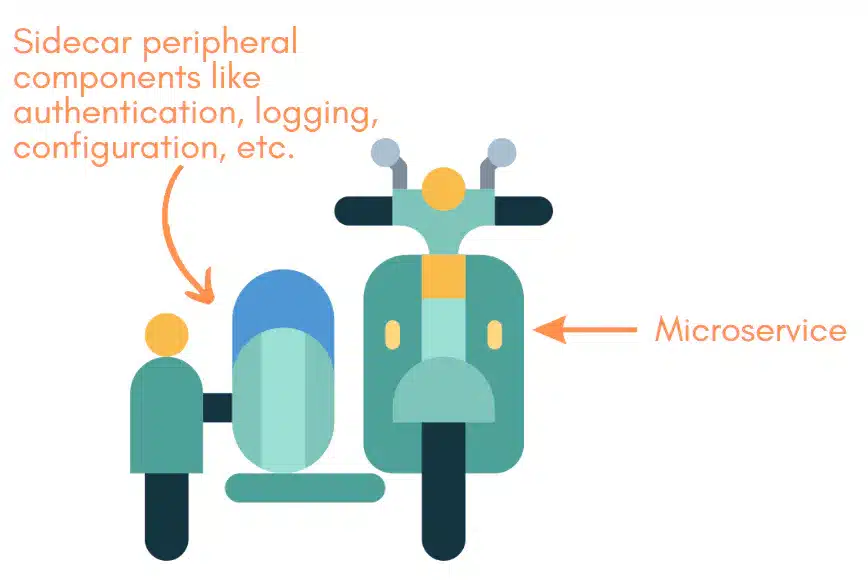Sidecar Pattern Performance
In this tutorial, we are going to discuss about the Sidecar Pattern Performance implications and special considerations.
The Sidecar Pattern comes with unique performance implications and special considerations that you must be aware of when using this pattern. Understanding these details is key to leveraging the full potential of the Sidecar Pattern.

The Sidecar pattern in software architecture introduces several performance implications, both positive and negative, depending on how it is implemented and the specific context of its usage. Here are some key points to consider regarding performance implications:
Positive Implications
- Isolation of Concerns: By separating the core application logic from auxiliary functionalities (logging, monitoring, caching), the Sidecar pattern promotes a clear separation of concerns. This can lead to cleaner, more maintainable code, which indirectly supports performance by reducing complexity.
- Scalability: Offloading non-core functionalities to sidecar containers can improve the scalability of the main application. For example, a caching sidecar can reduce the load on the main application by handling repetitive data requests locally.
- Flexibility in Technology: Sidecar containers can be independently deployed and updated, allowing each component to use different technologies or versions. This flexibility can enhance performance by enabling the use of specialized tools or optimizations tailored to specific tasks.
Negative Implications
- Overhead: Introducing additional containers (sidecars) adds overhead in terms of resource consumption (CPU, memory, network). Each sidecar consumes resources that could otherwise be used by the main application. This overhead can become significant if not managed properly.
- Increased Complexity: While the Sidecar pattern reduces complexity within the main application, it introduces complexity at the infrastructure level. Managing multiple containers, their interactions, and dependencies can be challenging and might affect overall system performance if not handled efficiently.
- Latency and Communication: Sidecar communication with the main application or other sidecars introduces network latency. Depending on the nature and volume of interactions, this latency can impact overall performance, especially in latency-sensitive applications.
Considerations for Performance Optimization
- Resource Allocation: Careful resource allocation and monitoring are crucial. Sidecar containers should be provisioned with appropriate resources to handle their tasks without starving the main application.
- Minimizing Overhead: Minimize the overhead introduced by sidecars by optimizing their resource usage, reducing unnecessary dependencies, and considering efficient communication protocols.
- Network Efficiency: Optimize network communication between the main application and sidecars to minimize latency. Consider local communication channels or lightweight protocols where possible.
- Monitoring and Tuning: Implement robust monitoring to identify performance bottlenecks introduced by sidecars. Tune configurations and deployments based on performance metrics to optimize overall system performance.
Understanding the Performance Implications
You might wonder, “Does adding a sidecar to my application slow things down?” A legitimate question, indeed. Let’s break it down.
The Sidecar Pattern can have some impact on performance, but it’s a trade-off you need to consider. Remember, each sidecar is an additional process running alongside your main application. This means more CPU, more memory, and more network bandwidth.
The sidecar’s resource usage may not be substantial in and of itself, but multiply that by the number of instances of your application, and it can add up quickly. Imagine, if you have hundreds or even thousands of instances of your application, each with its own sidecar, the cumulative resource usage can be significant.
In terms of latency, having a sidecar can also introduce an additional network hop. This is because requests might need to go through the sidecar before reaching the main application or an external service. While the latency introduced is usually negligible, in high-performance, low-latency systems, this could potentially become an issue.
However, remember that the slight performance impact often pales in comparison to the benefits. The sidecar enhances your application’s functionality and maintainability and improves the overall development and operational experience. You’ll need to balance these trade-offs.
Special Considerations: Tackling the Challenges Head-On
Now, let’s delve into some special considerations. To effectively leverage the Sidecar Pattern, there are specific aspects you need to pay attention to.
1. Sidecar and Main Application Versioning
Versioning becomes more complex with sidecars. How so? You need to manage versions of both the main application and the sidecar. What if a new version of the sidecar is incompatible with an older version of the main application or vice versa? How do you roll out updates? These are questions that you need to think about when using the Sidecar Pattern.
2. Shared Resources
Sidecars share resources with the main application, such as network and disk. It’s important to ensure that the sidecar doesn’t hog these resources, leaving nothing for the main application. You can manage this using resource limits and quotas at the container level.
3. Security
Sidecars often need to have similar security permissions as the main application to perform their tasks. This increases the attack surface and is something you need to carefully consider when designing your sidecar.
4. Complexity
Sidecars, while solving many problems, also add complexity. Developers and operators now need to understand and manage multiple parts instead of a single monolithic application.
By now, you might be thinking, “Is the Sidecar Pattern worth all these considerations?” But remember, the Sidecar Pattern is not a one-size-fits-all solution. Like any architectural pattern, it has its strengths and weaknesses, and its effectiveness depends on your specific use case.
In summary, while the Sidecar pattern offers significant advantages in terms of modularity, isolation, and scalability, it also introduces complexities and potential performance overheads. Careful design, monitoring, and optimization are essential to harness its benefits while mitigating its drawbacks in real-world applications.
That’s all about the Sidecar Pattern Performance implications and special considerations.. If you have any queries or feedback, please write us email at contact@waytoeasylearn.com. Enjoy learning, Enjoy Microservices..!!.!!